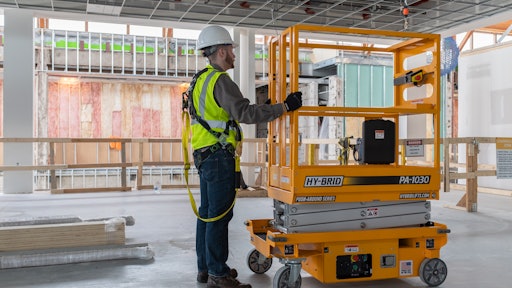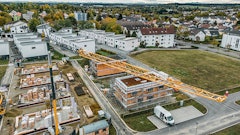
Last June’s National Employee Safety Month looked much different than this year’s. Spending is on the rise, restrictions are lifting, and jobs are abundant. Customers and contractors are sure to keep rental centers busier than ever this season for their work at height solutions and expert advice. But is rental ready?
This June, take advantage of National Employee Safety Month and get customers, and employees, up-to-date on safety and working efficiently with these latest work-at-height stats, equipment comparisons, and tips.
Setting the Stage
Ladders and scaffolds have long been the go-to solutions for elevated work — they’re simple to transport and don’t cost much to purchase or rent. While they excel in these areas, ladders and scaffolds continue to lag in one major, and potentially costly, area: safety.
According to data from Liberty Mutual’s 2020 Workplace Safety Index, workplace falls to a lower level led to $5.71 billion in direct costs to businesses. In fact, these types of injuries land right behind overexertion, the number one cause of workplace injuries. These costs from injuries directly impact profits and result in expensive downtime — the last thing rental centers want for their employees or their customers during perhaps the busiest season yet.
These numbers are staggering, and one could speculate that a fall is not a matter of if it will happen, but rather when. But, like many workplace injuries, most falls can be prevented with the right equipment. Low-level scissor lifts, for example, are compact and lightweight enough to work on finished floors, drive through doorways, and take a ride on an elevator, but, most importantly, they enhance safety by leaps and bounds.
Operators get a stable platform to stand on while performing work, and railings and harnesses protect them from falling. So what’s holding some renters and rental employees back from implementing safer alternatives like low-level lifts? Awareness. With the stage set, one of the best ways to instill awareness of safer options like low-level lifts is by diving deeper into their riskier alternatives, ladders and scaffolds.
Don't Fall for the Ladder
Low-level lifts show up to a jobsite and are ready to go, and one would think ladders do as well. Setting up a ladder, however, can be more complicated. From duty ratings to height guidelines, there are several factors to consider when choosing a ladder and setting it up for optimum safety. Unfortunately this knowledge is often overlooked and not communicated to users, making the risk of falls a very real concern. Here’s what all contractors and rental centers should know.
Ladders come in five duty ratings: Type III light duty, Type II medium duty, Type I heavy duty, Type IA extra heavy duty, and Type IAA extra heavy duty. Each is designed to safely handle a certain amount of weight. Exceed that weight and physics kicks in with the potential for the ladder to snap and cause severe injury. There is a safer way for workers to haul themselves and their materials to the elevated worksite and that’s with a low-level lift. Workers can place material on the lift’s platform and move from place to place on the jobsite. Some of the lifts even feature overload sensors that alert the user or limit the lift height if there is excess weight on the machine.
In addition to capacity, height is also a critical factor that is often overlooked when selecting a ladder. When it’s too short, it’s tempting to stand on the top rungs or overstretch beyond the rails, either of which can lead to a fall. A ladder that’s too tall is more likely to be set up incorrectly against a wall and can slip out from underneath a worker because there is not enough friction to hold it in place. Low-level lifts address these potential pitfalls by allowing users to maintain consistent stability across multiple working heights.
By eliminating daunting climbs and providing a step-in height as low as 20 inches, low-level lifts allow workers to quickly relocate without the hassles and fatigue of setting up. When projects require moving the ladder as work progresses, the contractor needs to climb down, fold up the ladder, carry it a few feet over, set it back up correctly, and climb up the rungs to start again. This not only is cumbersome and time-consuming, but it can easily fatigue a worker, which increases the risk for falls.
Properly setting up a ladder is challenging and leaves a generous amount of room for error. OSHA recommends that users ensure the top of the ladder extends 3 feet higher than the elevated surface, place it at a 75-degree angle, and set it one-quarter of the working height away from a wall. For instance, if the wall’s height is 40 feet, the base of the ladder should be 10 feet away. It’s often impractical to measure for these recommendations — or even have room to meet them — on the jobsite, but not following that guidance can substantially reduce the ladder’s stability. The challenge of properly setting up a ladder is likely why a growing number of contractors are choosing alternatives for their worksites.
Cutting safety corners for the sake of time and effort is also a concern with ladder usage. Overreaching can cause the ladder to topple over, and “walking” it — shifting side to side to move — can also cause it to tip or fold on itself. With low-level push-around lifts, the user brings the lift to the ground and pushes the unit to the next location. Or, with a self-propelled lift, the operator can simply drive to the next spot. Most lifts also use counterweights and tilt sensors to prevent tipping when pushing against the wall with tools.
These ladder pitfalls can cause some to reach for scaffolding instead.
Scaffolds Aren’t Much Different
Scaffolds can provide variable working heights and larger elevated platforms, which ladders cannot, but they still create some of the same safety challenges.
Just like ladders, scaffolds must be set up correctly to provide a stable framework and prevent collapse underneath the weight of workers, tools, and materials. Low-level scissor lifts are ready to go and require little, if any, assembly. They also make reaching elevated heights nearly effortless. Hauling tools and materials up and down scaffolding is a challenging and dangerous chore that can increase user fatigue and lead to more slips and falls.
Once a worker is on the deck, depending on the setup, a safety harness might be the only thing to prevent them from taking a perilous step off the side of the platform. Lifts, on the other hand, offer a fully encircled platform with 38- to 42-inch-tall railings and toeboards, which protect people below from falling tools and materials.
And just like when using ladders, operators using scaffolding are still tempted to sacrifice safety for productivity. When a scaffold needs to be moved, the worker needs to remove the deck and, in some cases, disassemble and reassemble the scaffolding at the new location. When a scaffold is on wheels, a user might try to “surf” an unsecured scaffold over to the new location by pulling on objects, such as overhead pipes and fixtures, around the work area. This takes the operator’s focus off of where the scaffold is traveling. And if the wheels encounter an object or an uneven surface, such as a ramp, the scaffold could tip.
On self-propelled low-level lifts, the user can focus more on the wheels’ path to avoid obstacles and uneven work surfaces while driving to the next location. And push-around lifts have automatic locking mechanisms on the wheels to prevent the unsafe surfing practice.
Prioritize Safety
The first step to enhancing elevated worksite safety is awareness, and rental centers are the perfect environment to introduce and instill a safety-first mindset in their employees and become a model and knowledgeable asset for their customers. Know where the risks lurk, understand why they are there, and then face them head on. Ladders and scaffolds pose some of the greatest risks for injuries on jobsites, but with low-level lifts, safety can easily be restored.




























